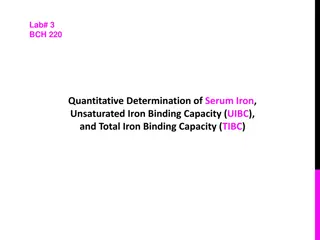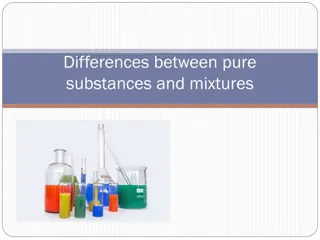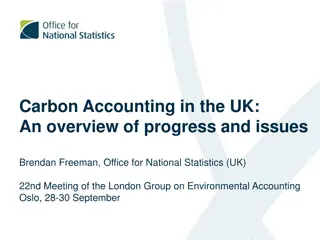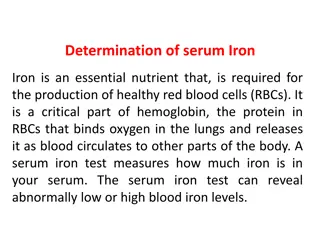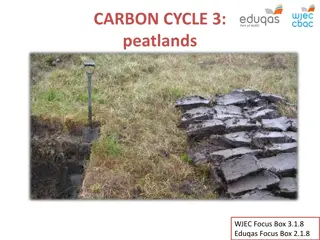Understanding the Iron-Carbon System and Allotropic Forms of Pure Iron
The Iron-Carbon system encompasses different crystalline forms of iron, known as allotropy, including alpha, gamma, and delta phases. Pure iron exists in these forms at specific temperature ranges. Alloys within the system, such as steel and cast iron, demonstrate distinct phases and properties based on carbon content. This overview delves into the structural characteristics and behaviors of the phases within the Iron-Carbon system.
Download Presentation

Please find below an Image/Link to download the presentation.
The content on the website is provided AS IS for your information and personal use only. It may not be sold, licensed, or shared on other websites without obtaining consent from the author. Download presentation by click this link. If you encounter any issues during the download, it is possible that the publisher has removed the file from their server.
E N D
Presentation Transcript
: - : - : Iron-Carbon system . . .
Allotropic Forms of Pure Iron Pure substances may exists in more than one crystalline form . this is known as allotropy. The pure iron exists in three allotropic i.e alpha ( ), gamma ( ) , and delta ( ) . the fig. below indicate the temperature ranges over which each of these crystographic forms are stable at atmospheric pressure . Note :- From room temperature to 910 C pure iron has a (BCC) structure and is called -iron. -iron is ferromagnetic at room temperature. But on heating to 768 C, the ferromagnetism disappears. From 910 C to 1404 C pure iron has a (FCC) structure and is called -iron. From 1404 C to 1539 C (melting point) pure iron has a (BCC) structure and is called -iron.
Iron-Carbon system The alloys of iron-carbon system containing from 0 to 2.0% carbon are called steels and those containing from 2.0% to 6.7% are called cast irons. In steels, the iron and carbon exists as two separate phases, ferrite and cementite. The ferrite is a solid solution of carbon in -iron with negligible a mount of carbon and cementite is intermetallic compound called iron-carbide (Fe3 C).Cementite is a stable phase in steels only. But it is not stable in cast irons and is called a metastable phase. Phase diagram of Iron-Iron-Carbon System The diagram shows the phases present at various temperatures for very slowly cooled iron-carbon alloys with carbon content up to 6.7%. Solid phases in Iron-Iron Carbide phase Diagram 1. -ferrite :- The solid solution of carbon in - iron is called -ferrite or ferrite. This phase has a (BCC) structure. And at 0%C it corresponds to - iron. And max. solid solubility of (C) in -ferrite to 0.02% at 723 C. This solubility decreases with the decrease of temperature until it is about 0.008% at 0 C. -ferrite is soft ductile, highly magnetic. Its density 7.88gm/cm3 and tensile strength is a bout 310 MPa. 2.Austenite:- The solid solution of carbon in - iron is called austenite. This phase has a (FCC) structure. The max. solid solubility of (C) in austenite to 2.11% at 1148 C. this solubility decreases with the decrease of temperature until it is about 0.8% at 723 C.
Cementite:- The intermetallic iron- carbon compound is called iron carbide or cementite ( Fe3C) this means that in cementite crystal lattice, the number of iron atoms are 3 times more that those of carbon atoms. cementite has a negligible solubility limits and contains 6.7% carbon and 93.3% iron. As compared to austenite and ferrite, cementite is extremely hard and brittle. -ferrite:- The solid solution of carbon in - iron is called -ferrite It has a (BCC) crystal structure but with a different lattice parameter than -ferrite and the max. solid solubility of (C) in -ferrite to 0.09% at 1495 C. Pearlite:- This structure is formed at the lower critical temperature of 723 C from autenite of carbon content 0.83%. the reaction to form pearlite is described as the eutectoid reaction and produces a liminated structure, which contains alternative layers of -iron adjacent to the iron carbide compound Fe3C. Note:- All alloys that contains less than 0.83% carbon is described as a hypoeutectoid. All alloys that contains above than 0.83% carbon is described as a hypereutectoid. Ledeburite:- This structure is formed at temperature of 1148 C and the eutectic composition of 4.3% carbon. This is a mixture of autenite and primary carbide and called ledeburite.













